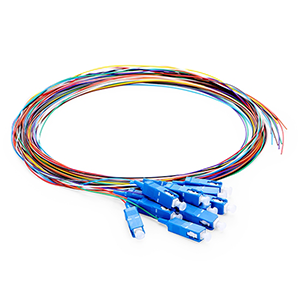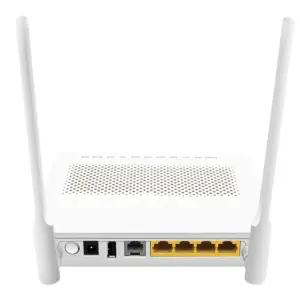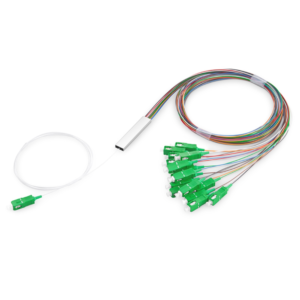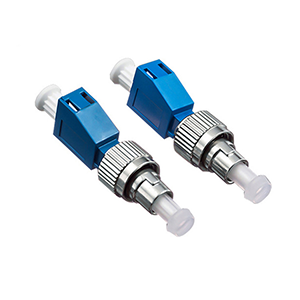Fiber patch cords play an important role in optical networks. This article will focus on comparing the advantages and disadvantages of APC (angled physical contact) fiber patch cords and DPC (dual angle physical contact) fiber patch cords. We will first explain the basic structure and function of fiber patch cords and explain their applications in optical networks. Next, we will define the characteristics and advantages of APC fiber patch cords.
Then, we will define the characteristics and advantages of DPC fiber patch cords. Finally, we will focus on comparing the differences between APC and DPC fiber patch cords in terms of end face shape, optical signal transmission, isolation, application scenarios, and cost, and explain the impact of these differences on network deployment.
Overview of Fiber Patch Cords
Fiber patch cords are short optical fiber connectors used to connect between devices or between devices and optical fibers. It is equipped with connectors to ensure stable transmission of optical signals. It is widely used in data centers, communication networks, and optical fiber testing to achieve efficient and reliable signal transmission.
Basic structure and function of fiber optic patch cord:
Fiber optic patch cord is a fiber optic cable used to connect optical network devices. Its basic structure includes:
(1) Fiber core:
- Responsible for the transmission of optical signals, which can be single-mode or multi-mode optical fiber.
(2) Protective layer:
- Including buffer layer, sheath layer, etc., providing mechanical and environmental protection.
(3) Fiber optic connector:
- Such as SC, LC, FC, etc., used for detachable connection with device ports.
The main function of fiber optic patch cord is:
- To interconnect optical network devices such as switches and routers with optical signals.
- Establish reliable optical transmission paths between devices to achieve end-to-end optical transmission.
- Ensure the transmission quality and reliability of optical signals during the connection process.
Through the flexible connection of optical fiber jumpers, a complete optical network topology can be formed.
Application of optical fiber jumpers in optical networks:
Optical fiber jumpers play a key role in optical networks, which is mainly reflected in the following aspects:
(1) Realize optical connection between devices:
- Connect various optical network devices, such as optical switches, routers, etc.
- Establish end-to-end optical transmission paths to complete the physical connection of optical networks.
(2) Support the construction of optical network topology:
- Flexible connector type and length selection to meet different network topology requirements.
- Simplify on-site construction and maintenance, and improve network deployment efficiency.
(3) Adapt to a variety of application scenarios:
- Widely used from access network, trunk network to data center.
- Meet the connection performance requirements of different optical networks.
(4) Ensure transmission quality and reliability:
- Good optical interface design ensures the quality of optical signal transmission.
- High reliability structural design improves the long-term stability of the connection.
In short, as the basic connection element in the optical network, the optical fiber jumper plays a key role in realizing optical transmission between devices, supporting network topology, adapting to a variety of applications and ensuring transmission quality. It is an indispensable and important component.
APC fiber patch cord
APC fiber patch cord (Angled Physical Contact) has a beveled end face design, which effectively reduces signal reflection and return loss, ensuring high-quality optical signal transmission. It is commonly used in fiber optic communications and data centers to improve signal integrity and system stability.
Features of APC fiber patch cord:
APC (Angled Physical Contact) fiber patch cord is a fiber optic connection cable with the following characteristics:
(1) Beveled end face design:
- The end face of the optical fiber core is processed into an angle of 8° to 15°.
- This beveled end face is the core design feature of the APC patch cord.
(2) High isolation and low reflection:
- The angled end face can reduce the reflection loss to an extremely low level, usually less than -60dB.
- APC patch cord can achieve an isolation of up to 60dB or more at the physical layer.
This special angled end face design is an important technical basis for APC fiber patch cord.
Advantages of APC fiber patch cord:
APC fiber patch cord has obvious advantages in the following aspects due to its excellent performance characteristics:
(1) Suppressing optical interference:
- The low reflection characteristics can effectively suppress the degradation of system performance caused by optical interference.
- Improve the overall reliability and stability of the optical network.
(2) Achieve high signal transmission quality:
- Extremely low reflection loss is conducive to ensuring the quality and stability of optical signal transmission.
- High isolation ensures the independence of different optical channels and avoids mutual interference.
In short, APC fiber jumpers, with their special angled end face design, have shown obvious advantages in suppressing optical interference and achieving high-quality signal transmission and other key performances, and are widely used in high-speed, high-performance optical networks.
DPC fiber jumpers
DPC fiber jumpers (Direct Physical Contact) adopt a planar contact design to optimize the optical signal transmission performance and reduce insertion loss and return loss. It is used in optical fiber communication systems that require high signal quality and stability to ensure reliable connections and high-quality data transmission.
Features of DPC fiber jumpers:
DPC (Dual Polished Connector) fiber jumpers are fiber optic connection cables with the following features:
(1) Dual-beveled end face design:
- Both ends of the fiber core adopt 8° to 15° beveled end faces.
- This dual-beveled end face design is the core technical feature of DPC jumpers.
(2) Ultra-low reflection characteristics:
- DPC jumpers can reduce reflection loss to an extremely low level, usually less than -65dB.
- This ultra-low reflection characteristic is one of the main advantages of DPC jumpers.
The double-angle end face design of the DPC patch cord is the key. Compared with the single-angle end face design of the APC patch cord, the performance of the DPC patch cord is further improved.
Advantages of DPC fiber patch cord:
DPC fiber patch cord has obvious advantages in the following aspects due to its ultra-low reflection characteristics:
(1) Extremely low reflection loss:
- The reflection loss of DPC patch cord can usually reach below -65dB, which is the highest level at present.
- This extremely low reflection characteristic can avoid interference and distortion of optical signals to the greatest extent.
(2) Ensure the quality of optical signals:
- The excellent reflection suppression performance is conducive to ensuring the quality and stability of optical signal transmission.
- It helps to improve the overall performance and reliability of optical network systems.
In short, DPC fiber patch cords, with their double-beveled end face design, have reached the industry-leading level in terms of reflection loss, which can ensure that the optical signal maintains extremely high quality during transmission and is widely used in optical network environments with extremely high signal quality requirements.
Comparison between APC and DPC fiber patch cords
APC fiber patch cords use a beveled end face design to reduce return loss and signal reflection, and are suitable for high-precision applications. DPC fiber patch cords use a flat contact design to optimize signal transmission, but the return loss is slightly higher than APC. APC is more suitable for environments with strict signal quality requirements.
End face shape:
(1) APC fiber patch cord:
- Uses a single-beveled fiber end face of 8° to 15°.
(2) DPC fiber patch cord:
- Use double-angle (8° to 15°) fiber end face.
The difference in end face shape directly affects the reflection characteristics of the two patch cords:
- The double-angle end face of DPC can reduce the reflection loss to below -65dB, which is better than the -60dB level of APC.
- Lower reflection loss helps DPC patch cords perform better in optical signal transmission.
Optical signal transmission:
(1) APC fiber patch cord:
- Excellent but slightly lower reflection suppression performance than DPC.
- It can effectively guarantee the optical signal transmission quality of most network applications.
(2) DPC fiber jumper:
- Extremely low reflection loss can ensure the extremely high quality of optical signal transmission.
- More suitable for professional-grade optical networks with extremely high signal quality requirements.
Optical signal transmission quality is a key factor affecting the performance of optical networks. DPC has shown obvious advantages in this regard due to its superior reflection characteristics.
Isolation:
(1) APC fiber jumper:
- Can achieve isolation of up to 60dB or more.
- It is conducive to suppressing optical interference and ensuring channel independence.
(2) DPC fiber jumper:
- The isolation index is slightly better than APC, reaching more than 65dB.
- Stronger isolation performance further enhances the ability to suppress optical interference.
Good isolation helps reduce the impact of optical interference on network performance, and DPC has a more obvious advantage in this regard.
Application scenarios:
(1) APC fiber jumper:
- Widely used in high-performance optical networks such as DWDM, FTTH, and data centers.
- It is currently the most widely used high-performance fiber jumper solution.
(2) DPC fiber jumper:
- Mainly used in professional-grade optical network systems with extremely high transmission quality requirements.
- Such as observatories, military communications and other fields have extremely high standards for signal quality.
Different application requirements determine the applicability of APC and DPC in actual deployment.
Cost factors:
(1) APC fiber patch cord:
- It is relatively mature and popular, and the price is relatively affordable.
(2) DPC fiber patch cord:
- The technology is relatively complex, the manufacturing cost is relatively high, and the price is significantly higher than APC.
Cost is one of the important factors affecting the selection of patch cords in practical applications, and it needs to be weighed in combination with specific needs.
In general, APC and DPC patch cords differ in end face shape, optical signal transmission, isolation, application scenarios and cost, and the appropriate fiber patch cord solution needs to be selected according to specific needs.
Summary
Choosing the right fiber patch cord is crucial to building a high-performance optical network. Our company has long been focusing on the research and development and application of APC and DPC fiber optic patch cords, and has rich practical experience. We provide various high-performance APC and DPC fiber optic patch cord products, which are widely used in data centers, 5G fronthaul, FTTH and other fields.
Our fiber optic patch cords adopt the industry-leading manufacturing process, and have achieved excellent levels in key performance indicators such as reflection loss and isolation. At the same time, our team of engineers will provide you with professional demand analysis and solution design services to ensure that the selected fiber optic patch cord can meet your actual needs to the greatest extent. Contact us now to learn more. We will do our best to provide you with the best quality products and solutions.
APC Patch Cord Adn DPC Patch Cord FAQ
An APC (Angled Physical Contact) patch cord is a fiber optic patch cable with connectors that have an angled end-face, designed to reduce signal reflection and improve return loss by minimizing the amount of light reflected back into the fiber.
A DPC (Direct Physical Contact) patch cord is a fiber optic patch cable with connectors featuring a flat end-face that makes direct contact with the opposite connector. This design provides a high level of signal transmission with minimal insertion loss but may have higher return loss compared to APC.
The angled end-face of an APC patch cord reduces signal reflection (return loss) by directing reflected light away from the fiber core. This improves signal quality and reduces interference, especially in high-speed and high-precision applications.
DPC patch cords, with their flat end-face, offer low insertion loss, making them suitable for applications where minimal signal loss is critical. They are typically used in environments where return loss is less of a concern.
APC patch cords are preferable in scenarios requiring very low return loss, such as high-speed fiber optic networks and telecommunications, where minimizing signal reflection is crucial for performance.
While DPC patch cords can be used in high-speed applications, they may not be ideal where very low return loss is required. APC patch cords are often preferred for high-speed and high-precision applications due to their superior performance in minimizing reflection.
DPC patch cords may be suitable for applications where return loss is not as critical, and where low insertion loss is the primary concern. Examples include certain types of local area networks (LANs) or environments with less stringent performance requirements.
Consider factors such as the importance of return loss versus insertion loss for your application. If minimizing signal reflection is critical, an APC patch cord is a better choice. For applications where insertion loss is the primary concern and return loss is less critical, a DPC patch cord may suffice.
APC and DPC patch cords are generally compatible with standard fiber optic equipment, but it’s important to ensure that the connectors on your equipment match the type of patch cord you are using. APC connectors typically match with other APC connectors, and DPC connectors with DPC connectors.





